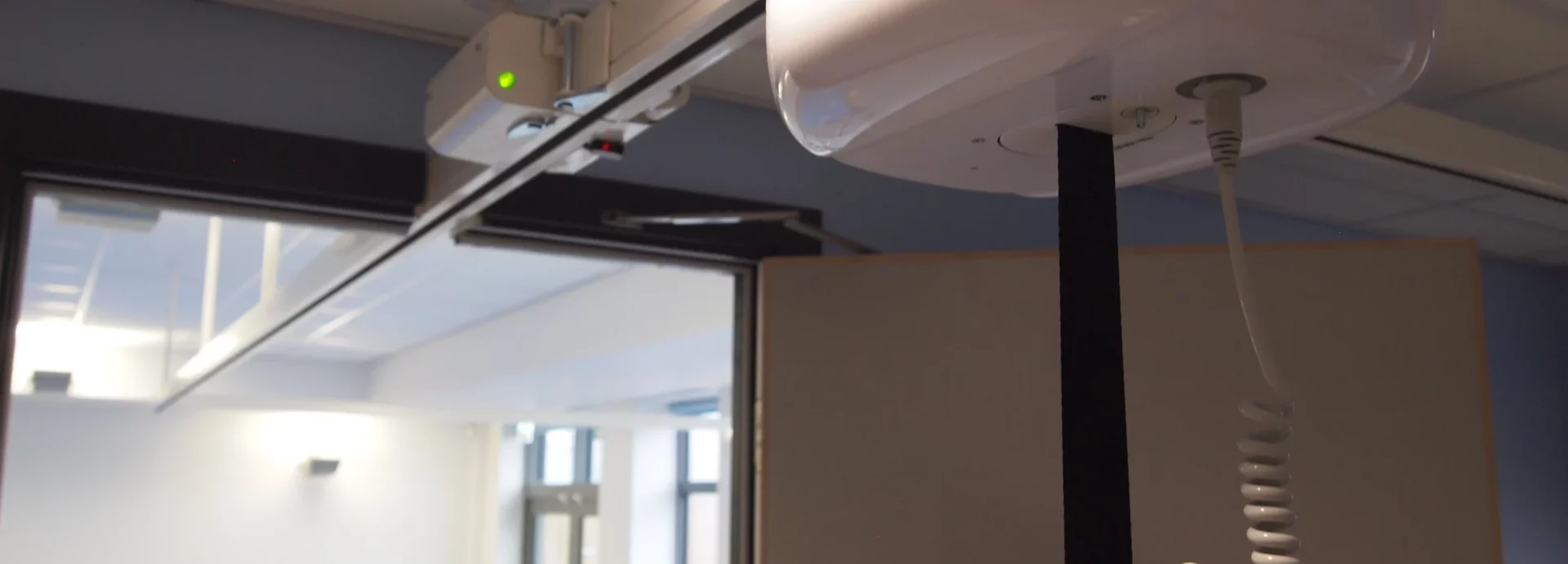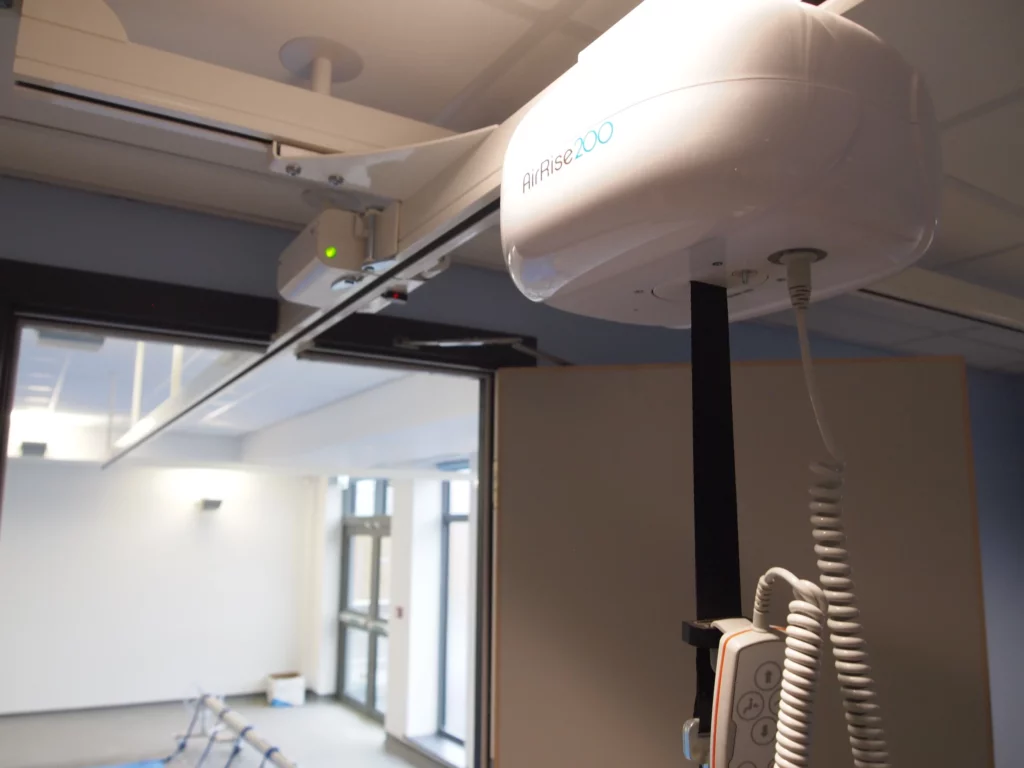What is a ceiling track hoist? How is it installed?
Posted on 24 January 2017 By Aaron Stretton

In This Article
A ceiling track hoist is an overhead hoisting system — the track can either be hung from the ceiling itself,…
A ceiling track hoist is an overhead hoisting system — the track can either be hung from the ceiling itself, hung from wall to wall, or inset to the ceiling itself for a neater, tidier looking system. Ceiling track refers to the tracking that the hoist unit moves along.
Ceiling track hoists are just one facet of the world of hoisting. This phrase gets thrown around a lot by healthcare professionals and architects, so it’s definitely worth knowing and understanding.

What are the benefits of a ceiling track hoist?
Ceiling track hoists are great for getting users from A to B easily and efficiently. This is beneficial for both the carer and the individual as it requires a lot less manual handling, therefore reducing the chances of the caregiver injuring themselves.
Since it is mounted to the ceiling, the hoist takes up no floor space, meaning that it doesn’t get caught up in furniture (beds, chairs, etc.) and it doesn’t have to be pushed over difficult surfaces, likes carpets. Ceiling track hoists also have more movement than a mobile hoist unit; they can lift higher and lower, facilitating a range of transfers that would otherwise be impossible with a mobile model.
Ceiling Track Hoist Installation
Before anything is installed, it’s important that the environment is checked by an overhead hoist specialist. Whether it’s a ceiling track hoist H-system or a straight track, they’ll look at the ceiling, wall, and floor structure to determine how the track will be mounted.
Then the overhead hoist specialist, along with the client and perhaps the carer, will identify how many lifting points are needed, and where they should be. The toilet, bed, and bath the most common lifting points in a room with an en-suite bathroom.
The overhead hoist specialist needs this information so that they can determine the structure and route of the ceiling track.
Ceiling Track Hoist Mounts
The installation of a ceiling track hoist is perhaps a little more complex due to the many options and methods available.
Architects and clients must consider the requirements of the end user, and the structure of the room itself. For example, typical ceiling joists are not normally designed to accommodate the weight of an overhead hoisting system (including the user’s weight on top of that).
With rooms where timber joists are used in the ceiling, the best way to fit and install a tracking system is with a metal unistrut or load spreading beams of at least equal strength, which span above the joists. There are then different methods of installation with concrete and steel fixings to offer the sturdiest, most robust support.
All information on this can be found in our specifier’s guide on pages 14 to 25.
Distance Between Fixings
The distance between these hoist tracking fixings depends on the weight that the system is required to take. The higher the weight limit of the hoist, the closer the fixings should be.
So an AirRise260 (that has a 260kg safe working load) will require 1.5 metres between fixings on a 65mm profile, or 4 metres on a 120mm profile. A curved track will have three fixed points for maximum security.
In terms of traverse rails on X-Y systems, if the distance between the parallels is over 4 metres, another parallel rail is advised.
Overhead Hoist Tracking
The track itself is the next thing to consider. Should the user require moderate coverage from the hoist, a straight track with optional features will suffice.
This is a fixed track that is hung, or installed in the ceiling and gives the user the freedom to move to any point along the line of the track. The track will be hung using a metal threaded rod through the unistrut, and secured in place with a nylon nut and a full nut.
This kind of fixture will be used on static rails, like fixed tracks. Fixed tracks used for more simple transfers like beds to wheelchairs, but it can be altered to allow for movement between environments.
Fixed tracks can be fitted with track switches, which work a bit like railroad tracks to alternate between routes that the user can take into different rooms. Turntables are also available; they rotate to alternate between different track layouts and directions.
The fitting will also be used on the static tracks of an X-Y system. Otherwise known as a H-frame, the X-Y system comprises of two parallel, fixed tracks, and a traverse rail hanging underneath that moves along these tracks to provide hoisting abilities anywhere within the range.
This track does tend to take up more space due to the fact that it is hung one from the other, however, there is a remedy for environments with low ceilings. The traverse rail can be between hung; this means that the traverse rail itself is lifted up so that it fits in between the two static ones, offering just as much movement with minimal space taken.
Transit Coupling
Although X-Y systems already offer a lot of flexibility in their structure, they do only cater to one room. Transit couplings can be installed to allow transfers from room to room, connecting an X-Y system to a fixed rail system, or to another X-Y system.
Our AirGlide360 transit coupling uses sensors to gauge when the user is switching from the X-Y to the fixed track and vice versa. It locks the track in place magnetically, facilitating a smooth, effortless transfer with unlimited possibilities.
Summary
Ceiling track hoists offer a world of benefits in care environments and beyond. Boasting flexible setups that can transfer from almost any point in the room, ceiling track systems are an excellent choice when looking at easy long-term hoisting options.
Similarly, the installation process itself is fairly simple and can be carried out in just a couple of days. The variety of tracking and hoist units means that there’s a unique system that can be specified for every environment.
Read our other blog What is a Hoist? for even more information
Speak to The Experts
Need assistance with product enquiries, general inquiries, or product support? Our Phonelines are open 9am - 5pm Monday to Friday
0113 519 0319
Or, fill out the form for a call back.
